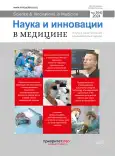Изменения качества жизни при социальной изоляции у пожилых пациентов с нарушением зрения
- Авторы: Агарков Н.М.1,2, Попова Н.В.2
-
Учреждения:
- ФГБОУ ВО «Юго-Западный государственный университет» Минобрнауки России
- ФГАУ «НМИЦ «МНТК «Микрохирургия глаза» имени академика С.Н. Федорова» Минздрава России, Тамбовский филиал
- Выпуск: Том 9, № 4 (2024)
- Страницы: 268-271
- Раздел: Геронтология и гериатрия
- URL: https://journal-vniispk.ru/2500-1388/article/view/277324
- DOI: https://doi.org/10.35693/SIM635050
- ID: 277324
Цитировать
Полный текст
Аннотация
Цель – определение характера изменения качества жизни у пожилых пациентов с нарушением зрения при социальной изоляции и связанных с ней факторов риска.
Материал и методы. Была сформирована клиническая группа из 115 участников 60–74 лет с нарушением зрения, находящихся в условиях социальной изоляции в течение месяца. В соответствии с Хельсинкской декларацией социальная изоляция была определена на основе 15-балльной шкалы, опросник качества жизни использовался для измерения изменений в качестве жизни. Факторы риска включали социально-демографические, клинические категории и показатели функционального состояния.
Результаты. Результаты линейных смешанных моделей со случайными пересечениями, сравнивающих показатели качества жизни до (3,30) и после социальной изоляции (1,78), были значимыми (p<0,001). Во время социальной изоляции у 87% участников с нарушением зрения наблюдалось снижение качества жизни (-2,39), тогда как у 13% участников наблюдалось повышение качества жизни (0,58). С социальной изоляцией были связаны следующие факторы риска: низкий уровень доходов (38%, p<0,001), отсутствие высшего образования (29%, p=0,002), заболевание легких (25%, р=0,04), функциональные или сенсорные нарушения, включающие трудности с приготовлением пищи (28%, p=0,004), трудности с прохождением одного квартала (26%, р=0,03), нарушение слуха (23%, р=0,02) и нарушение зрения (24%, p=0,01). Незначимыми оказались пол (р=0,39), текущая боль (р=0,75), трудности с повседневными действиями (p=0,09), недержание мочи (р=0,82), сахарный диабет (p=0,87) и когнитивные нарушения (р=0,06).
Заключение. Период социальной изоляции привел к весьма значительному снижению общего качества жизни в выборке пожилых людей с нарушением зрения. Ведущими факторами риска социальной изоляции оказались низкий уровень доходов и отсутствие высшего образования.
Ключевые слова
Полный текст
Открыть статью на сайте журналаОб авторах
Н. М. Агарков
ФГБОУ ВО «Юго-Западный государственный университет» Минобрнауки России; ФГАУ «НМИЦ «МНТК «Микрохирургия глаза» имени академика С.Н. Федорова» Минздрава России, Тамбовский филиал
Автор, ответственный за переписку.
Email: anton-titov-2001@mail.ru
ORCID iD: 0000-0002-4821-3692
д-р мед. наук, профессор кафедры биомедицинской инженерии
Россия, Курск; ТамбовН. В. Попова
ФГАУ «НМИЦ «МНТК «Микрохирургия глаза» имени академика С.Н. Федорова» Минздрава России, Тамбовский филиал
Email: mntk@mntk-tambov.ru
ORCID iD: 0000-0003-0202-7795
врач-офтальмолог отделения лазерной хирургии
Россия, ТамбовСписок литературы
- Holt-Lunstad J, Smith TB, Baker M, et al. Loneliness and social isolation as risk factors for mortality: a meta-analytic review. Perspect Psychol Sci. 2015;10(2):227-237. DOI: https://doi.org/10.1177/1745691614568352
- Donovan NJ, Blazer D. Social Isolation and Loneliness in Older Adults: Review and Commentary of a National Academies Report. Am J Geriatr Psychiatry. 2020;28(12):1233-1244. DOI: https://doi.org/10.1016/j.jagp.2020.08.005
- Waite LJ. Social Well-Being and Health in the Older Population: Moving beyond Social Relationships. In: Future Directions for the Demography of Aging: Proceedings of a Workshop: National Academies Press. 2018. DOI: https://doi.org/10.17226/25064
- Hawkley LC, Capitanio JP. Perceived social isolation, evolutionary fitness and health outcomes: a lifespan approach. Philos Trans R Soc Lond B Biol Sci. 2015;370(1669):20140114. DOI: https://doi.org/10.1098/rstb.2014.0114
- Hawton A, Green C, Dickens AP, et al. The impact of social isolation on the health status and health-related quality of life of older people. Qual Life Res. 2011;20(1):57-67. DOI: https://doi.org/10.1007/s11136-010-9717-2
- Leigh-Hunt N, Bagguley D, Bash K, et al. An overview of systematic reviews on the public health consequences of social isolation and loneliness. Public Health. 2017;152:157-171. DOI: https://doi.org/10.1016/j.puhe.2017.07.035
- Xia N, Li H. Loneliness, Social Isolation, and Cardiovascular Health. Antioxid Redox Signal. 2018;28(9):837-851. DOI: https://doi.org/10.1089/ars.2017.7312
- Lev IV, Agarkov NM, Starodubtseva LV. Geriatric management tactics for patients with diabetic retinopathy. Research Results in Biomedicine. 2023;9(1):129-141. [Лев И.В., Агарков Н.М., Стародубцева Л.В. Гериатрическая тактика ведения пациентов с диабетической ретинопатией. Научные результаты биомедицинских исследований. 2023;9(1);129-141]. DOI: https://doi.org/10.18413/2658-6533-2023-9-1-0-9
- Agarkov NM, Lev IV, Kopylov AE. Biological age as a risk factor for ophthalmological complications in type 2 diabetes mellitus. Research Results in Biomedicine. 2023;9(3):383-392. [Агарков Н.М., Лев И.В., Копылов А.Е. Биологический возраст как фактор риска офтальмологических осложнений при сахарном диабете 2-го типа. Научные результаты биомедицинских исследований. 2023;9(3):383-392]. DOI: https://doi.org/10.18413/2658-6533-2023-9-3-0-8
- Agarkov NM, Kopylov AE, Titov AA, et al. Features of geriatric status in patients with arterial hypertension and coronary heart disease (review). Research Results in Biomedicine. 2024;10(1):112-125. [Агарков Н.М., Копылов А.Е., Титов А.А. Особенности гериатрического статуса у пациентов с артериальной гипертензией и ишемической болезнью сердца. Научные результаты биомедицинских исследований. 2024;10(1):112-125]. DOI: https://doi.org/10.18413/2658-6533-2024-10-1-0-7
- Frisch M.B. Evidence-Based Well-Being/Positive Psychology Assessment and Intervention with Quality of Life Therapy and Coaching and the Quality of Life Inventory (QOLI). Social Indicators Research. 2013;193-227. DOI: https://doi.org/10.1007/s11205-012-0140-7
- Valtorta NK, Kanaan M, Gilbody S, et al. Loneliness and social isolation as risk factors for coronary heart disease and stroke: systematic review and meta-analysis of longitudinal observational studies. Heart. 2016;102(13):1009-1016. DOI: https://doi.org/10.1136/heartjnl-2015-308790
- Hakulinen C, Pulkki-Råback L, Virtanen M, Jokela M, Kivimäki M, Elovainio M. Social isolation and loneliness as risk factors for myocardial infarction, stroke and mortality: UK Biobank cohort study of 479 054 men and women. Heart. 2018;104(18):1536-1542. DOI: https://doi.org/10.1136/heartjnl-2017-312663
- Barth J, Schneider S, von Känel R. Lack of social support in the etiology and the prognosis of coronary heart disease: a systematic review and meta-analysis. Psychosom Med. 2010;72(3):229-238. DOI: https://doi.org/10.1097/PSY.0b013e3181d01611
- National Academies of Sciences E, and Medicine. Social Isolation and Loneliness in Older Adults: Opportunities for the Health Care System. In: The National Academies Press; Washington, D.C.: 2020.
- Holt-Lunstad J, Smith TB, Layton JB. Social relationships and mortality risk: a meta-analytic review. PLoS Med. 2010;7(7):e1000316. DOI: https://doi.org/10.1371/journal.pmed.1000316
- Zhang Y, Ma ZF. Impact of the COVID-19 Pandemic on Mental Health and Quality of Life among Local Residents in Liaoning Province, China: A Cross-Sectional Study. Int J Environ Res Public Health. 2020;17(7):2381. DOI: https://doi.org/10.3390/ijerph17072381
Дополнительные файлы







